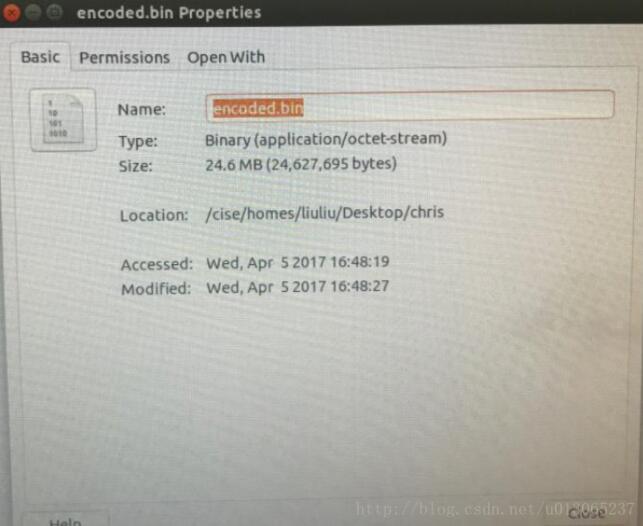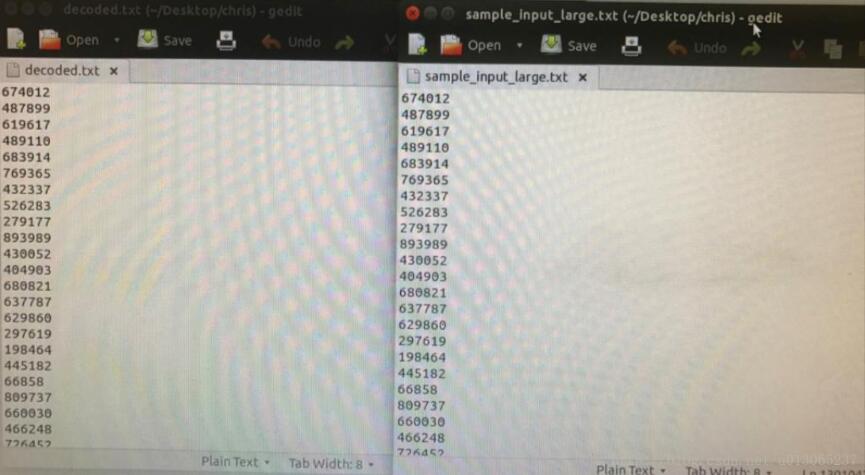Huffman编码主要是通过统计各元素出现的频率,进而生成编码最终达到压缩的目的。
这里是Huffman树中节点的结构。
typedef struct Tree
{
int freq;//频率
int key;//键值
struct Tree *left, *right;
Tree(int fr=0, int k=0,Tree *l=nullptr, Tree *r=nullptr):
freq(fr),key(k),left(l),right(r){};
}Tree,*pTree;
首先用一个名为freq的hashtable来记录各个元素的频率:
void read(){
int a;
std::ios::sync_with_stdio(false);
while(cin>>a){
if(freq.find(a)==freq.end()) {freq[a]=1;}
else {freq[a]++;}
}
}
Huffman树的构建过程如下代码所示:
void huffman()
{
int i;
string c;
int fr;
auto it = freq.begin();
while(it!=freq.end()){
Tree *pt= new Tree;
pt->key = it->first;
pt->freq = it->second;
it++;
th.Insert(pt);//此处的th为一种优先队列
}
while(true)//构建哈夫曼树
{
Tree *proot = new Tree;
pTree pl,pr;
pl = th.findMin();
th.Delete(0);
if(th.isEmpty()){
th.Insert(pl);
break;
}
pr = th.findMin();
th.Delete(0);
//合并节点
proot->freq = pl->freq + pr->freq;
std::ios::sync_with_stdio(false);
proot->left = pl;
proot->right = pr;
th.Insert(proot);
//合并后再插入
}
string s;
print_Code(th.findMin(), s);
del(th.findMin());
}
其中print_Code和del函数如下:
void print_Code(Tree *proot, string st)//从根节点开始打印,左0右1
{
if(proot == NULL)
return ;
if(proot->left)
{
st +='0';
}
print_Code(proot->left, st);
std::ios::sync_with_stdio(false);
if(!proot->left && !proot->right)
{
cout<<proot->key<<" ";
for(size_t i=0; i<st.length(); ++i){
cout<<st[i];ml+=st[i];
}
cout<<endl;encoded[proot->key]=ml;ml="";
}
st.pop_back();
if(proot->right)
st+='1';
print_Code(proot->right, st);
}
void del(Tree *proot)
{
if(proot == nullptr)
return ;
del(proot->left);
del(proot->right);
delete proot;
}
至此就完成了Huffman的编码。
当然,由于huffman的编码都是0或1,因此需要进行位的表示才能完成压缩。注意,位需要以8个为一组进行写入:
while(in>>a){
int x=atoi(a.c_str());
auto m=encoded.find(x);
//encoded是另外一个哈希表用于记录元素及它的编码
if(m==encoded.end()) continue;
else {
string t=m->second;
ss+=t;
}
}
unsigned char buf = 0;
int count = 0;
int i = 0;
while(ss[i] != '\0')//位写入,8个为一组
{
buf = buf | ((ss[i++]-'0') << (7 - count));
count++;
if (count == 8)
{
count = 0;
fout << buf;
buf = 0;
}
}
if(count != 0)
fout << buf;
至此就完成了Huffman的编码以及压缩,效果十分可观:
当对69.6M的txt文件(其中含有大约10000000个数据)进行压缩时,产生的encoded.bin文件仅为24.6MB:Ubuntu测试环境:

下面进行Huffman解码的解说:
Huffman解码首先是根据编码表进行huffman树的重建:
void decode(){
auto it=decoded.begin();
Tree *p=proot;
while(it!=decoded.end()){
string s=it->first;int t=it->second;int i=0;
while(i<s.length()){
if(s[i]=='0') {
if(proot->left==nullptr) proot->left=new Tree(5);
proot=proot->left;
}
else{
if(proot->right==nullptr) proot->right=new Tree(5);
proot=proot->right;
}
i++;
}
proot->data=t;
proot=p;
it++;
}
}
然后读取bin文件的一系列位:
while (f.get(c)){
stringstream a;
for (int i = 7; i > 0; i--)
a<<((c >> i) & 1);
a<<(c&1);
m+=a.str();//将位转为字符串
}
然后用Huffman树根据左0右1进行查找并输出:
int i=0;Tree *p=proot;
while(i<m.length()){
if(m[i]=='0'&&proot->left!=nullptr)
{proot=proot->left;i++;}
else if(m[i]=='1'&&proot->right!=nullptr)
{proot=proot->right;i++;}
else
{cout<<proot->data<<endl;proot=p;}
}
至此就完成了Huffman树的解码:

总的来说,Huffman对于大数据的压缩效果是很好的,运行时间也很快,大概需要20s就可以完成对1000000个数据的编码压缩。
难点在于位的写入与读取,花了相当多的精力进行操作。
以上就是本文的全部内容,希望对大家的学习有所帮助,也希望大家多多支持自学编程网。

- 本文固定链接: https://zxbcw.cn/post/185614/
- 转载请注明:必须在正文中标注并保留原文链接
- QQ群: PHP高手阵营官方总群(344148542)
- QQ群: Yii2.0开发(304864863)
